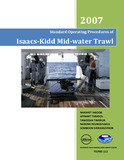Standard Operating Procedures of Isaacs-Kidd Mid-water Trawl
Share
Abstract
Isaacs-Kidd mid-water trawl (IKMT) is oceanography tool used to collect bathypelagic biological specimens larger than those taken by standard plankton nets. The trawl consists of the specifically designed net attached to a wide, v-shaped, rigid diving vane sometime called a depressor. The vane keeps the mouth of the net open and exerts a depressing force, maintaining the trawl at depth for extended periods at towing speeds up to 5 knots, but the optimum towing speeds should be 2-3 knots because of the high level of drag exerted by the net in the water. The inlet opening is unobstructed by the towing cable.
The IKMT is a long, round net approximately 6.50 m long, with a series of hoops decreasing in size extending from the mouth of the net to the rear (cod) end, which measures an additional 2 m in length. The hoops maintain the shape of the net during towing. The mouth of the net is 1.75 m wide by 1.30 m high, and is attached to a depressor.
The IKMT's largemouth opening and capacity for fast towing speeds enables capture a wider range of relatively large and more active organisms than smaller nets. In addition, its fine mesh allows it to snag animals that are not retained in the large trawl nets that are used for commercial fishing. Thus, it is well suited for capturing an array of fishes, squids and shrimp that inhabit the mid-water zone. To make sample collection easier, the IKMT is always used in conjunction with echo-sounders which provide a target area for the researchers to sample.


